skip to main |
skip to sidebar
Until yesterday, I'd only ever seen nankhatai in photos on various blogs (most of them very, very beautifully shot photos, I might add). Never seen them in real life, never eaten any (not that I know of and not by that name), never baked any. Since Diwali is next week, and because I'd just bought a lovely big bag of pistachios recently, and also because our friends were going to drop by and I wanted to bake something for them with an Indian touch, I decided to make nankhatai with the pistachios and the last of my stash of saffron. The recipe I followed is on Nandita's Saffron Trail blog. My only two additions were pistachio nuts in the dough itself, and extra milk as the ghee alone was nowhere near enough to bind the mixture together to make a dough.
And what a good decision it was. I love saffron - although I don't use it often because it's expensive - and I love pistachios, and I know they're a flavour match made in heaven (fictitious place, obvs, but the match is very real and the flavours are very lovely!). These cookies are very moreish - they're not too sweet, the saffron flavour is awesome, the pistachios are delicious and the semolina gives the nankhatai a lovely crunch. Be sure to use fine semolina, though, otherwise, the nankhatai might have a sandy mouthfeel rather than crispness. Happy eating, people!
Recipe for: Kesar pista nankhatai (saffron pistachio cookies)
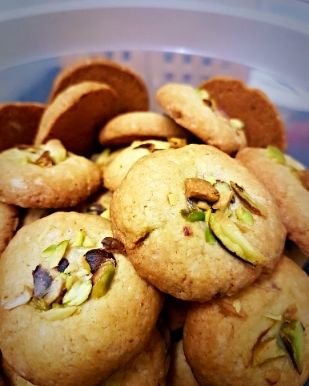
Ingredients:
1.5 cups plain flour
2.5 tbsp chickpea flour
1/2 tbsp fine sooji (semolina)
1/2 tsp baking soda
1/4 cup slivered pistachio nuts
2 tbsp finely chopped pistachios (optional)
1/2 cup powdered sugar
1/2 cup melted ghee (clarified butter)
1/4 tsp saffron strands, crushed in a small mortar-pestle
Milk as required
Method:
1. Preheat the oven to 180C/350F.
2. Sift together the flours, semolina and baking soda in a medium bowl. Mix in the slivered pistachio nuts and set aside. Warm 2 tbsp of the milk and let the saffron steep in it for 5 minutes.
3. In a large bowl, mix together the ghee, powdered sugar and saffron-milk until smooth, then add the flour mixture. Add extra milk a tablespoon at a time until you can form a soft dough. Be careful not to add too much liquid.
4. Roll the dough into balls the size of large marbles and place on a cookie sheet lined with non-stick paper or foil, leaving a gap of about 1.5 inches. At this point, if you wish, you can make a dimple in the centre of each cookie with your thumb and sprinkle a pinch of the chopped pistachios. If not, just flatten each ball slightly and place in the preheated oven.
5. Bake for 15-18 minutes or until the cookies are a pale brown, switching the tray around after 10 minutes so that they brown evenly.
6. Remove to a wire cooling rack. The cookies will crisp up as they cool.
7. Try not to eat all the nankhatai yourself.
I don't make sweets often, but once in a while something like Cilantro's fruit kesari catches my fancy, and then it's like a craving - so here's my craving, which I made yesterday. It's just a coincidence that it's Deepavali and the kesari is appropriate as an offering. It's even more convenient that I could use up some over-soft soft fruit that I might have thrown away if not for the craving.
Now if only someone would make me thenkuzhal and thattai...
Ah well. Happy Deepavali to everybody, and may light and happiness be ever in your lives.
Recipe for: Fresh fruit rava kesari
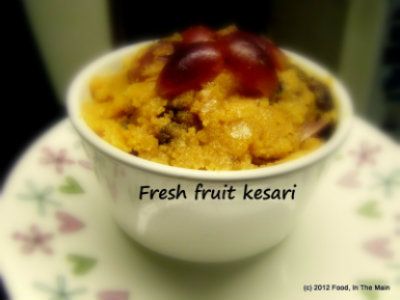
Ingredients:
1/2 cup rava/sooji/semolina
1-1/2 cups water
1/8 tsp saffron threads (a pinch) left to soak in 1/4 cup warm milk for 15 minutes
10-12 seedless red grapes, halved or quartered
1 small orange, peeled and segments chopped
1 small ripe banana, chopped
1 small ripe plum, stoned and chopped
1 tbsp raisins or sultanas (optional)
1/2 cup sugar
1/4 tsp cardamom powder
5 tsp ghee
2 tbsp nuts (I used walnuts and pecans)
Method:
1. Heat 2 tsp ghee in a heavy-based medium size pan and fry the rava/sooji/semolina on medium heat, stirring frequently, for about 5 minutes till the rava turns a slightly darker shade and smells roasted. Be careful that it doesn't burn. Remove to a bowl till required.
2. In the same pan, heat another tsp ghee and fry the nuts on medium heat, stirring till they are fragrant and turn a darker shade. Remove the nuts from the pan and reserve.
3. Heat the fourth tsp of ghee in the same pan, and add all the fruits, letting them cook on medium-low heat till they are soft and squishy, about 5 minutes.
4. Now add the water and sugar. Bring to a boil, then lower the heat a little and let it simmer for 5 minutes, stirring until the sugar dissolves completely.
5. Add the roasted rava/sooji/semolina now, stirring all the while to mix evenly. Let this cook until the kesari begins to thicken, then add the saffron milk and stir it in. Keep stirring frequently to ensure that it does not burn or become lumpy.
6. When the kesari is no longer watery and has "come together" in a soft mass, stir in the fried nuts along with the remaining tsp ghee. Serve the kesari warm in small bowls.
Tip: You can also spread the kesari on a greased plate and let it cool, then cut it into squares or diamonds for a more elegant (and convenient) presentation.
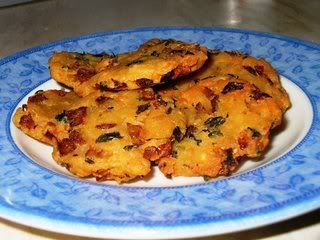
Yep, they look nice, dont they? :) They WERE nice. Ever since I saw the recipe for maddur vada on Latha's blog a few weeks ago, by sheer chance (I'd googled "maddur vada"), I'd been hankering to make them. They're simple to make, and really best eaten fresh while they're still fairly crisp. I personally liked their chewy texture a day on, but I think that could just be me, a one-woman fan club.
I used the same ingredients as specified in Latha's recipe, but made a small addition of my own - urad dal that had been soaked for 2-3 hours. I think I had a vague of idea of the really really scrummy "Tirupati vada" that I'd eaten long ago, before the Tirupati laddoo became the only prasadam (holy offering) available. The Tirupati vada was dark brown, very chewy, and had urad dal in it. I havent a clue about the rest of the ingredients in that prasadam - all i remembered was the texture and the fact that there was urad dal in it.
The urad dal DID make a difference to the maddur vada - if only in taste. I'm quite glad I made the addition!
Recipe for: Maddur vada
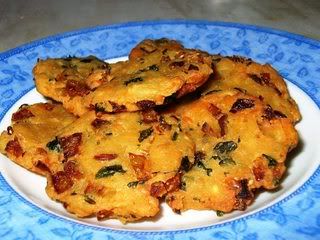
Ingredients:
1 cup fine semolina
1/2 cup rice flour
1/4 cup plain flour
1 tsp red chilli powder
5 tbsp hot oil for kneading
2 onions, finely chopped
1/2 cup urad dal, soaked for 2-3 hours
1/2 cup coriander leaves, chopped
10-15 fresh curry leaves, chopped
Fresh green chillies to taste, minced
Salt to taste
Oil for deep frying
Method:
1. Heat the oil in a deep pan.
2. Put the rice flour, plain flour, semolina, red chilli powder and salt in a bowl. Add 5 tbsp hot oil and and mix well with a wooden spoon.
2. Add the chopped onions, urad dal, coriander, curry leaves and chillies.

Mix with enough water to make a rough dough. Use your hand for this.
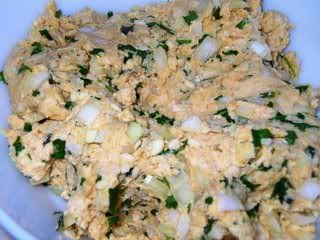
3. Take a small ball of this dough and flatten with your fingers (or use a glass, greasing its bottom well) on a non-stick sheet.
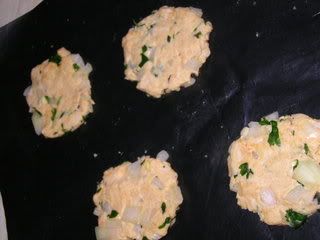
4. Drop into hot oil and deep fry on medium-high heat until golden brown.
5. Serve hot with any dipping sauce.








